

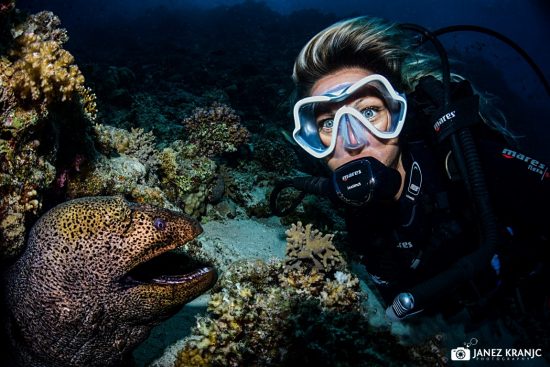
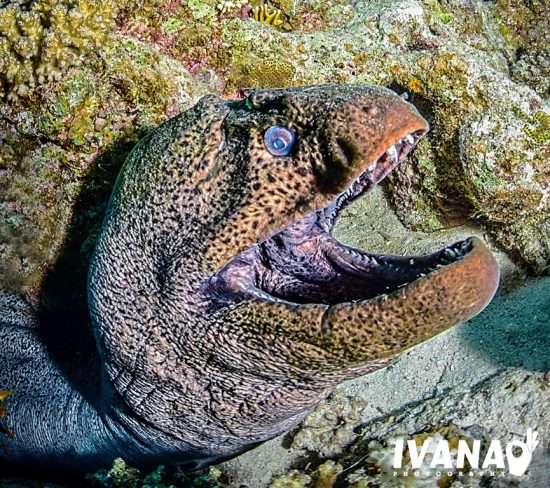
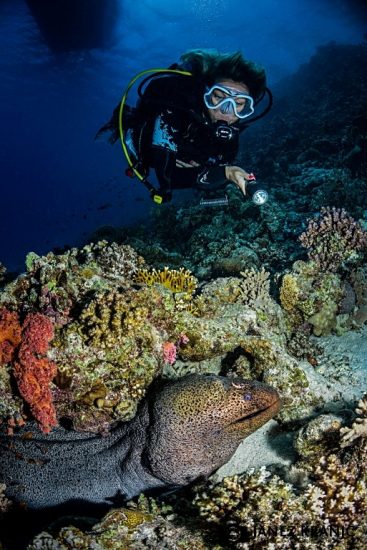
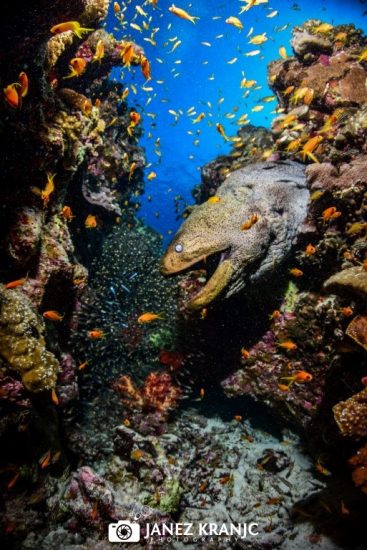
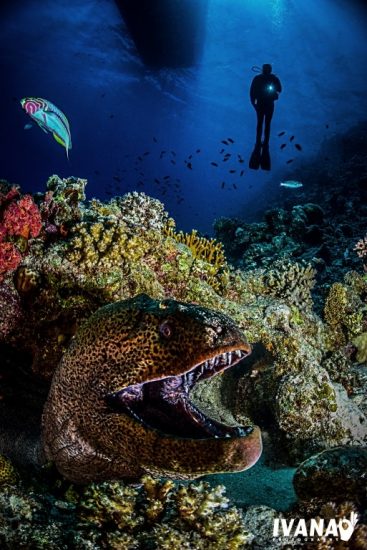
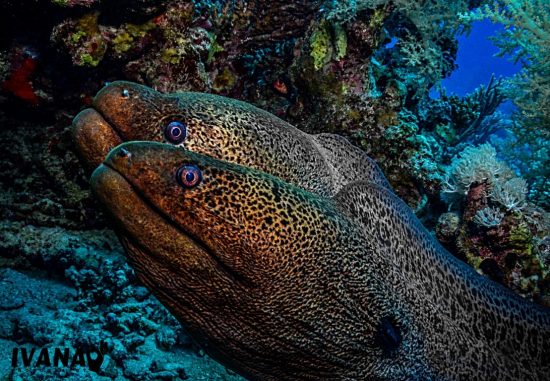
Sometimes ugly, sometimes frightening, and of imposing size, the Giant Moray Eel is the master of the coral reefs of the Red Sea. With incredibly flexible, adaptable bodies, they easily slide through the narrowest passages among the corals. Even if they are not in a bad mood, their menacing appearance and their strong jaws command respect from divers. Mutual respect and admiration is the desirable relationship required between a diver and a Giant Moray Eel.
Do you like snakes? Well if you met a Giant Moray Eel, which can grow to 3 meters in length and weigh roughly 30kg, in the warm waters around Egypt, you would think at first that you are looking at a large snake. Their dorsal, caudal and anal fins are joined, meaning they look more like snakes than fish. Moray’s are shy by nature and are to be found hiding among corals and rocks. They are easily identified by their leopard skin pattern and black colouring around their gill openings. Don’t be fooled by their sluggish appearance though! Morays can move very fast and are extremely flexible.
Their little eyes make them almost cute looking but are not very useful to them as they depend on their excellent sense of smell to locate their food. They are not fussy eaters and will be happy with a breakfast consisting of crustaceans, lunch with molluscs and cephalopods and some fish for dinner.
Morays are night hunters, but won't say no to a quick snack if it passes by during the day. They make a perfect team with Roving Coral Groupers when they squeeze into crevices and scare their prey which often swims into the mouth of a patiently waiting grouper. The eels actively recruit the groupers by shaking their heads from
side to side encouraging them to join them in the hunt.
Even though they are not the friendliest looking fish, they do not attack unprovoked and avoid confrontation by hiding out of the way; but when provoked or tempted with food, they can do some considerable damage. Many over eager and foolish divers who have tried to hand feed Giant Moray Eels have lost their fingers to their menacing bite. The Giant Moray’s bite is very special; it inspired the creator of ‘Alien’ to develop his character with two sets of jaws. When Morays strike, once latched on, they are unable to let go as they are the only fish with two sets of jaws. The first grabs the prey and holds it, while the second set of jaws positioned
in their throat pulls the victim into their digestive system. There is no escape once captured…does that sound horrible enough to deter you from feeding eels???
Another interesting fact about the Giant Moray is that they literally die for sex… well, not exactly sex, but to reproduce. They sometimes need to travel over 4000 miles to find the perfect mate or place to breed. They have both female and male organs, so there is no problem if the ideal mate is of the opposite sex. Well… It’s both anyway! Win/win situation you would think, but this is not the case. They make the ultimate sacrifice to produce offspring. After waiting until the temperature of the water rises to the ideal temperature for their offspring, they release their eggs and sperm in an embrace and…die…
The baby eels, called elvers, once hatched, float in the ocean for around eight months, and it takes them three years before they find the perfect home where they will eventually settle and have a life expectancy of between 6 to 36 years.
Not many people eat Giant Moray Eels which are thought to contain high levels of Ciguatoxin which is dangerous to humans. Unless they are caught by a fisherman by accident they can live happily in the warm waters of Egypt until nature calls.
In summary, the Giant Moray Eels of Egypt are sometimes ugly, sometimes frightening and of imposing size, and they are masters of the coral reefs of the Red Sea. With incredibly flexible and adaptable bodies, they easily slide through the narrowest passages among the corals. Even if they are not in a bad mood, their menacing appearance and their strong jaws command respect from divers. Mutual respect and admiration is the desirable relationship required between a diver and a Giant Moray Eel.
Authors: Janez Kranjc, MARES ambassador in cooperation with Bogna Griffin, Marine Biology Student GMIT (Galway Mayo Institute of Technology), Ireland.
 Mares
Mares 12th May 2017
12th May 2017 Mar Rosso
Mar Rosso 
